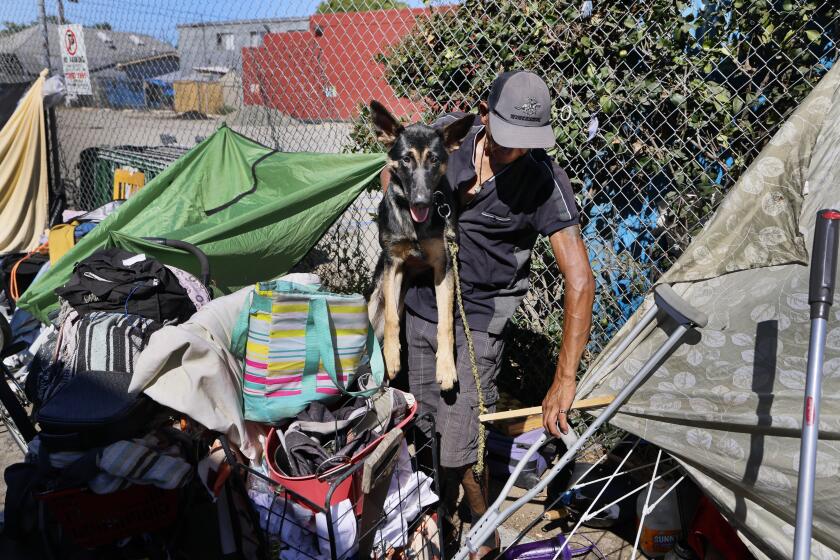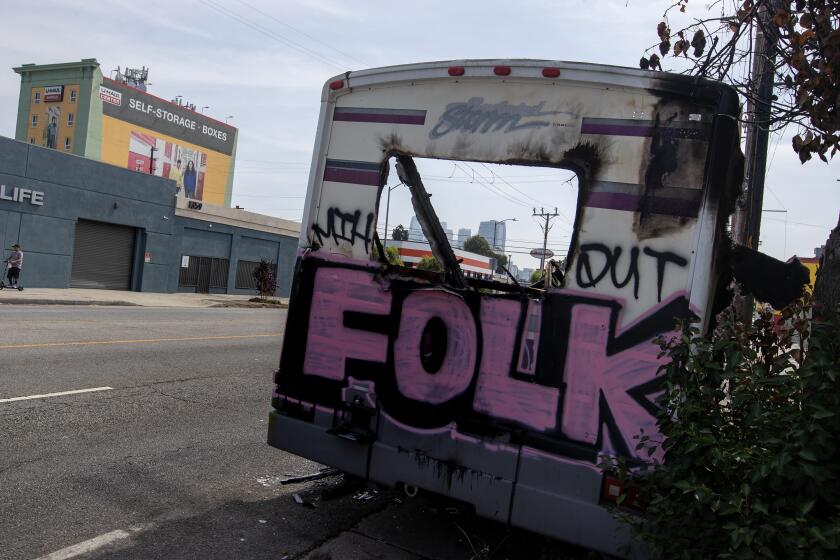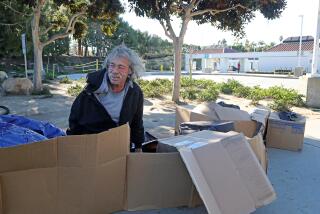Santa Monica could ban sleeping bags, bedrolls in public areas in crackdown on camping

The Santa Monica City Council is set to consider amendments to its anti-camping ordinance Tuesday night that would remove a section that allows homeless people to use pillows and blankets while sleeping on public property.
The existing ordinance prohibits tents and makeshift shelters in public areas but allows homeless people to sleep using blankets and pillows under certain circumstances.
The proposed amendments would continue the current distinction between camping on public property, which is forbidden, and sleeping on public property, which is not. To help define and identify people who are camping illegally, the proposed amendments would add sleeping bags and bedrolls to the list of items prohibited in public areas.
But the most controversial proposed change would strike out a small section of the ordinance that allows homeless people to use pillows, blankets and bedrolls while sleeping on public property, exemptions that were added in 2022 to comply with an appeals court ruling.
City officials maintain that despite the proposed change, they are not considering banning sleeping in public places, nor would they ban the use of blankets. The changes, they say, are meant simply to clarify what constitutes “camping.”
The proposal to revise the city’s outdoor camping ordinance comes in response to a U.S. Supreme Court decision that has prompted cities through California to reconsider their homeless policies.
Mayor Phil Brock did not respond to requests for comment. But in an interview with KTLA, Brock said the changes are an attempt to clean up the streets.
“It’s nothing draconian — nothing onerous,” he told the station. “But I feel that if you have someone you’ve offered help to four, five, six times and they won’t move off the street, then we need to somehow get them off the street, get them into treatment, get them into rehab.”
Santa Monica Councilmember Jesse Zwick said that while he understood the need to control public spaces and encourage unhoused people to go indoors, he didn’t think the proposed changes were an effective approach.
“I think it’s sort of a fantasy on the part of legislators to believe that if you write down something [as] illegal that it will go away,” he said.
Zwick hopes the city will instead spend its energy on increasing its supply of affordable housing and permanent supportive housing. Not doing so, he said, would be cruel and cynical, given the changes the council is considering.
Although city staff have recommended that the council approve the amendments, it also provided city leaders with two other options: take no action, or wait to see what other cities do to address homeless encampments.
The amendments were scheduled to be addressed at the last council meeting Aug. 27, but the discussion was postponed. That meeting drew dozens of residents who wanted to voice their opinion on the anti-camping ordinance, while others showed up to speak against a proposed permanent supportive housing project.
Long Beach has begun enforcing its anti-camping laws. City officials say they are emphasizing compassion in the sweeps, but police say they won’t hesitate to issue fines and citations if needed.
Homelessness is not a new issue in Santa Monica. People have long been drawn to the popular beach town, but a series of violent crimes on the city’s promenade and beaches where tourists gather has raised concerns about public safety and frustration over the city’s handling of the homelessness crisis.
Last summer, a man who appeared to be homeless assaulted Brock on the Third Street Promenade. Brock was a councilmember at the time of the attack. In May, a homeless man assaulted three people on the same street, stabbing at least two German tourists. The following month, Santa Monica police arrested a homeless man who attacked three people on the beach, including an elderly woman and a 17-year-old girl.
Currently, there are an estimated 774 people experiencing homelessness in Santa Monica, a 6% drop from 826 in 2023, according to the city’s recent homeless count. At least 62% of the unhoused population lives outdoors.
Officials say the city has been able to enforce its anti-camping laws in part because of programs that help prevent people from falling into homelessness, such as STEP Court, which allows people to clear misdemeanor records by obtaining housing assistance and mental health and substance use treatment. The city also partnered with Los Angeles County to launch the Therapeutic Van Transport Team, which works alongside first responders to provide support for people experiencing behavioral health crises.
The city said it also has shelter beds to move people indoors, although the city still falls about 100 beds short of the number needed to fully accommodate the unsheltered population.
Two measures were approved Friday by the Los Angeles City Council to enforce existing parking laws for RVs and other vehicles that homeless people use for shelter
The proposed changes to the city’s anti-camping ordinance stem from a July City Council meeting in which Mayor Pro Tem Lana Negrete and Councilmember Oscar de la Torre asked city staff members to “evaluate and provide options to amend the city’s municipal code” in light of the recent U.S. Supreme Court ruling.
Negrete and de la Torre did not respond to requests for comment.
In June, the country’s high court overturned a ruling by the 9th Circuit Court of Appeals that ordinances in Grants Pass, Ore., banning camping and sleeping in public violated the 8th Amendment by constituting cruel and unusual punishment for people who had no other place to go. The Supreme Court decision freed cities and counties to ban people from sleeping or camping on public property, even if there was no available shelter.
Shortly after that ruling, California Gov. Gavin Newsom directed state agencies to begin clearing homeless encampments from state lands and urged cities and counties to do the same. Newsom also threatened to take money away from cities and counties that did not make progress in clearing homeless camp sites.
Shortly thereafter, city officials in Long Beach began to crack down on homeless encampments that they deemed to be problematic, issuing citations to anyone who violated the city’s anti-camping ordinance.
Long Beach officials maintained that citations and arrests would be used only after outreach teams exhausted every effort to encourage people to go indoors.
The Santa Monica City Council meeting is scheduled to begin at 5:30 p.m. Tuesday.
More to Read
Sign up for Essential California
The most important California stories and recommendations in your inbox every morning.
You may occasionally receive promotional content from the Los Angeles Times.














